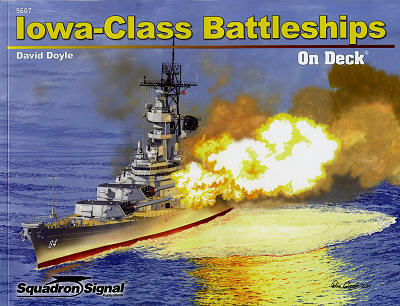 Though a relic
of a bygone age, the battleship still fascinates both enthusiasts and those with
only a passing interest in ships. Arguably the pinnacle of the class were the US
Navy's Iowa class battleships. Six were started with the last two, the Illinois
and Kentucky scrapped before completion, leaving the Iowa, Missouri, Wisconsin
and New Jersey as the ships of the class that were finished. Experience in WWII
put air power to the forefront as the major offensive weapon, relegating the
battleship to what was basically floating long range artillery, a job they
performed with distinction.
Though a relic
of a bygone age, the battleship still fascinates both enthusiasts and those with
only a passing interest in ships. Arguably the pinnacle of the class were the US
Navy's Iowa class battleships. Six were started with the last two, the Illinois
and Kentucky scrapped before completion, leaving the Iowa, Missouri, Wisconsin
and New Jersey as the ships of the class that were finished. Experience in WWII
put air power to the forefront as the major offensive weapon, relegating the
battleship to what was basically floating long range artillery, a job they
performed with distinction.
After the war, with no need for these ships, they were
mothballed for future use. And a good thing as they were used in their role as
artillery during both Korea and Vietnam. In the latter conflict, they were so
effective that their withdrawal was specified in talks between the US and North
Vietnamese. During the Regan military expansion, the return to service of the
Iowa class ships with upgrades were part of his '600 ship' Navy. Thanks to this,
your editor was able to visit the USS Missouri when on active duty during the
1980s when she docked in Diego Garcia and in San Diego a few years later.
Impressed with their size, it was also interesting to note that compared to
modern aircraft carriers, these were not large ships.
Eventually, they lasted long enough to participate in
Desert Storm, firing Tomahawk missiles as much as using their main battery. That
was the last gasp of the big gun ships as they are now museum pieces in various
parts of the US, where folks can walk their decks and wonder what it might have
been like to serve on them.
Author David Doyle provides a short background history and
then the rest of the book is photographs. This covers the construction of the
ship, the major external features, some of the internal areas of the ship, and,
of course, many images of the ship, a goodly number from US Navy sources as well
as from the current museum ships. This allows for the vast majority of images in
the book to be in full color, something that Squadron/Signal likes to do with
its detail books.
In all, it makes for a fascinating book that many will read
with some nostalgia and others with great interest. It is a book I can easily
recommend to you.
July 2011
My thanks to Squadron Products for the review copy. Get yours
today at your favorite shop or on-line retailer.
If you would like your product reviewed fairly and quickly, please
contact me or see other details in the
Note to Contributors.
 Though a relic
of a bygone age, the battleship still fascinates both enthusiasts and those with
only a passing interest in ships. Arguably the pinnacle of the class were the US
Navy's Iowa class battleships. Six were started with the last two, the Illinois
and Kentucky scrapped before completion, leaving the Iowa, Missouri, Wisconsin
and New Jersey as the ships of the class that were finished. Experience in WWII
put air power to the forefront as the major offensive weapon, relegating the
battleship to what was basically floating long range artillery, a job they
performed with distinction.
Though a relic
of a bygone age, the battleship still fascinates both enthusiasts and those with
only a passing interest in ships. Arguably the pinnacle of the class were the US
Navy's Iowa class battleships. Six were started with the last two, the Illinois
and Kentucky scrapped before completion, leaving the Iowa, Missouri, Wisconsin
and New Jersey as the ships of the class that were finished. Experience in WWII
put air power to the forefront as the major offensive weapon, relegating the
battleship to what was basically floating long range artillery, a job they
performed with distinction.